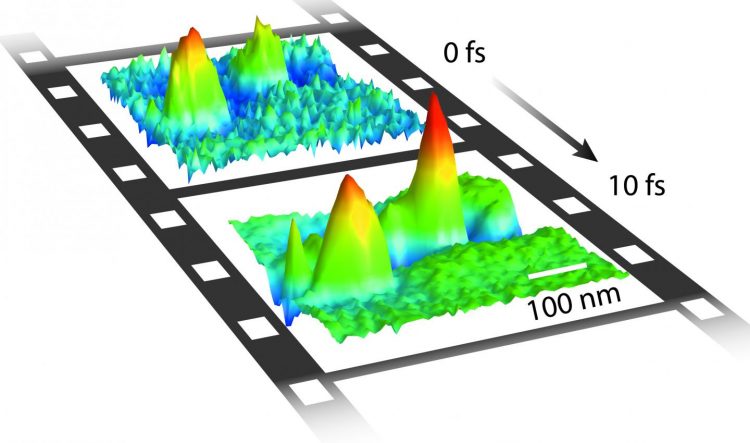CU-Boulder ultrafast microscope used to make slow-motion electron movie

This is an image captured by CU-Boulder researchers using an ultrafast optical microscope shows clouds of electrons oscillating in gold material in space and time. The width of the image is 100 nanometers (about the size of a particle that will fit through a surgical mask), while the time between the top and bottom frame (10 fs, or femtoseconds) is less than 1 trillionth of a second. Credit: University of Colorado
The ultrafast optical microscope assembled by the research team is 1,000 times more powerful than a conventional optical microscope, said CU-Boulder physics Professor Markus Raschke, lead study author.
The “image frame” rate, or speed captured by the team, is 1 trillion times faster than the blink of an eye, allowing the researchers to make real-time, slow-motion movies of light interacting with electrons in nanomaterials – in this case a thin gold film.
“This is the first time anyone has been able to probe matter on its natural time and length scale,” said Raschke. “We imaged and measured the motions of electrons in real space and time, and we were able to make it into a movie to help us better understand the fundamental physical processes.”
A paper on the subject appears in the Feb. 8 issue of Nature Nanotechnology.
Matter is sometimes described as the “stuff of the universe” – the molecules, atoms and charged particles, or ions, that make up everything around us. Matter has several states, most prominently solid, liquid and gas.
According to the CU-Boulder researchers, a number of important processes like photosynthesis, energy conversion and use, and biological functions are based on the transfer of electrons and ions from molecule to molecule. The team used a technique called “plasmonic nanofocusing” to focus extraordinarily short laser pulses into tiny bits of gold film matter using a nanometer-sized metal tip.
“Our study brings nanoscale microscopy to the next level, with the ability to capture detailed images evolving on extremely fast time scales,” said Vasily Kravtsov, a CU-Boulder graduate student in physics and first author of the paper.
Other co-authors on the Nature Nanotechnology paper include CU-Boulder postdoctoral researcher Ronald Ulbricht and former CU-Boulder postdoctoral researcher Joanna Atkin, now a faculty member at the University of North Carolina-Chapel Hill.
“This work expands the reach of optical microscopes,” said Raschke. “Using this technique, researchers can image the elementary processes in materials ranging from battery electrodes to solar cells, helping to improve their efficiency and lifetime.”
Unlike electron microscope approaches, the new technique does not require ultra-high vacuum techniques and is particularly promising for studying ultrafast processes like charge and energy transport in soft matter, including biological materials, said Kravtsov.
###
The study was funded in part by the National Science Foundation with support from the Pacific Northwest National Laboratory.
Contact:
Markus Raschke, 303-492-1366
markus.raschke@colorado.edu
Jim Scott, CU-Boulder media relations, 303-492-3114
jim.scott@colorado.edu
Media Contact
All latest news from the category: Physics and Astronomy
This area deals with the fundamental laws and building blocks of nature and how they interact, the properties and the behavior of matter, and research into space and time and their structures.
innovations-report provides in-depth reports and articles on subjects such as astrophysics, laser technologies, nuclear, quantum, particle and solid-state physics, nanotechnologies, planetary research and findings (Mars, Venus) and developments related to the Hubble Telescope.
Newest articles

NASA: Mystery of life’s handedness deepens
The mystery of why life uses molecules with specific orientations has deepened with a NASA-funded discovery that RNA — a key molecule thought to have potentially held the instructions for…

What are the effects of historic lithium mining on water quality?
Study reveals low levels of common contaminants but high levels of other elements in waters associated with an abandoned lithium mine. Lithium ore and mining waste from a historic lithium…

Quantum-inspired design boosts efficiency of heat-to-electricity conversion
Rice engineers take unconventional route to improving thermophotovoltaic systems. Researchers at Rice University have found a new way to improve a key element of thermophotovoltaic (TPV) systems, which convert heat…



